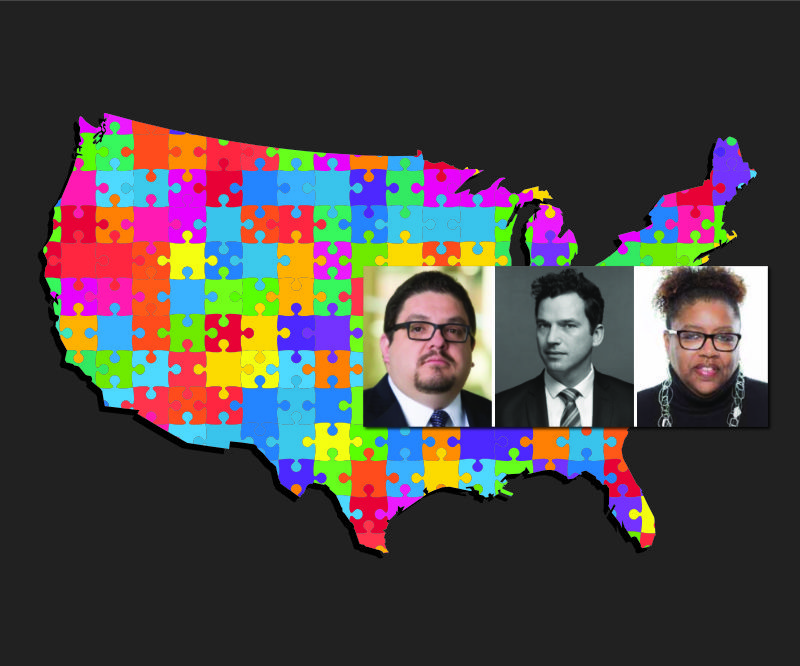The Foundation of American Democracy – Fair Redistricting
(Above, Inset: l-r): Mark Hugo Lopez, Director of Hispanic Research, Pew Research Center; Yurij Rudensky, Redistricting Counsel, Brennan Center for Justice. NYU Law School; Jesselyn McCurdy, Interim Executive Vice President for Government Affairs, The Leadership Conference Education Fund.
The Census 2020 data brought forth some very interesting demographic changes in the United States. Data revealed that 40% of the counted population are minority groups – Hispanics, African Americans, Asians, and Native Americans. There is a shift of population from rural areas to suburban/urban communities. The conspicuous statistic, however, is that 58% of the counted population identified as non-Hispanic, American Whites – the lowest ever recorded. This has become a political issue for a certain party and there is now a push for gerrymandering and unfair redistricting tactics which could potentially break the foundation of our democracy.
According to the Pew Research Center, based on the 2020 U.S. Census data:
- S. population reached 331.4 million
- The Hispanic population grew 23% from 2010-2020, reaching 62.1 million and 19% of the U.S. population
- The number of Black, single-race non-Hispanic Americans reached 40 million, or 12%
- The Asian non-Hispanic population reached 20 million and made up 6% of the national population
- The American Indian/Alaska Native non-Hispanic population reached 2.3 million, or about 0.7%
- The White non-Hispanic population fell from 196.8 million in 2010 to 191.7 million in 2020, reaching its lowest share of the U.S. population ever
- Geographically, 32 states had population increases since 2010 but also had White non-Hispanic population declines
- DC (up 25%), Utah (up 11%) and Idaho (up 10%) had largest White non-Hispanic population increases since 2010
More Americans than ever say they are multiracial
- 8 million Americans identify as being of more than one race in 2020, up from about 9 million in 2010
- About half of multiracial Americans are Hispanic
- Most multiracial Americans say they are White with another race
- The White alone or in combination group stood at 235.4 million, up since 2010, though its share fell.
- The second-largest racial group was made up of people who said their race is Some Other Race, at 49.9 million.
- The Black alone or in combination population reached 46.9 million.
This information was presented by Mark Hugo Lopez, Director of Race and Ethnicity Research at the Pew Research Center.
With increasing diversity and the increasing population of minority groups, politicians – particularly conservatives – are pushing for voting rights restrictions – think Texas. We face another challenge as part of the minority population – a fight for our fundamental participation in the ‘democracy haven’ we live in.
Yurij Rudensky, Redistricting Counsel at the Brennan Center for Justice, explains that redistricting process can be abused for the sake of power. Going more in-depth on Gerrymandering, Rudensky explains “The goal is to lock in an electoral advantage for a party, but there are also racial gerrymanders to minimize the political influence of voters of color.”
Rudensky lays out three frameworks to tackle gerrymandering.
- Give control to an independent commission. The commission can be made up of representatives throughout the political spectrum who aren’t active politicians and/or lobbyists.
- Powerful safeguards – legal policies – that can be used in court to police redistricting.
- Get more people involved in the redistricting process.
Jesslyn McCurdy, Interim Executive Vice President for Government Affairs, The Leadership Conference Education Fund, gives us a Call-To-Action. “Unless you take immediate and direct action to fully protect against racial discrimination at the ballot box and to ensure that every voice and vote counts, we will lose it…” McCurdy asserts that both the John Lewis Act and For the People Act need to pass Senate for fairer voting rights and equal representation for People of Color.


